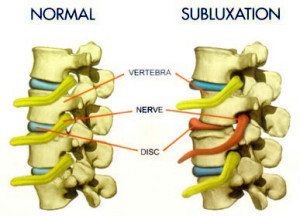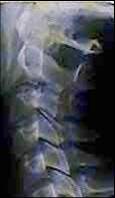Vertebral Subluxation Treatment

A vertebrae that loses its normal position in the spine causing nerve interference or nerve pressure. The vertebrae becomes fixated and stuck (hypo mobile) out of place. Subluxations can occur in any joint in the body, but occur most commonly in the spine. Your nervous system controls every cell, tissue, organ and system of your body. These nerve impulses travel through your spine. So having a spine free of vertebral subluxations is essential for optimal health.
sub = less than | luxation = dislocation
Vertebral Subluxation Complex
Chiropractors are remarkably unique in the health care field as they are the only health care professionals trained to detect and treat a condition referred to as the ” Vertebral Subluxation Complex”. Chiropractors have found vertebral subluxations to be responsible for and contribute to a number of spinal and extra-spinal disorders.
What Is The Vertebral Subluxation?
The vertebral subluxation is the term applied to a vertebra that has lost its normal position and/or motion in relation to neighboring vertebrae. Vertebrae which do not function properly within the spinal framework generate mechanical stress. This accelerates the wear and tear on the surrounding spinal muscles, ligaments, discs, joints,s and other spinal tissues. Pain, palpatory tenderness, inflammation, decreased spinal mobility, and muscle spasm and hypertonicity will eventually follow.
Additionally, because of the direct mechanical and physiological relationship between the spinal column and the spinal nerve roots, vertebral subluxations as well as other spinal abnormalities have the potential to impair proper nerve functioning. Once nerve functioning is compromised, communication within the body becomes less effective jeopardizing the overall health and wellness of the individual.
Additionally, because of the direct mechanical and physiological relationship between the spinal column and the spinal nerve roots, vertebral subluxations as well as other spinal abnormalities have the potential to impair proper nerve functioning. Once nerve functioning is compromised, communication within the body becomes less effective jeopardizing the overall health and wellness of the individual.
What Is The Subluxation Complex?
Through extensive research and study chiropractors have identified 5 components of vertebral subluxation. Collectively, these elements are known as the “subluxation complex”.
1. Kinesiopathology – the loss of normal vertebral positioning and motion in relation to neighboring vertebrae.
2. Myopathology – pathological changes occurring in the spinal musculature which includes hypertonicity, spasming, fibrosis, weakness, and improper or inappropriate functioning.
3. Neuropathology – irritation or injury to spinal nerve roots through compression, stretch, or more commonly chemical irritation from nearby spinal structures.
4. Histopathology – pathological changes which occur to the spinal tissues such as abnormal bony growths off the vertebral bodies and joints, fibrosis and adhesions of spinal muscles and ligaments, as well as dehydration and degeneration of spinal discs.
5. Pathophysiology – the biochemical changes taking place in the spinal region which include inflammatory biochemicals from injured tissues and biochemical waste products.
Each component of the subluxation must be eliminated for proper healing to occur and for the rehabilitation process to be successful. While a full understanding of all components is not necessary, you should be aware of the complexity involved. Patients should also be aware that pain is but a small element of most diseases and disorders. Pain is a very poor indicator of your need for further treatment as pain generally subsides well before tissue healing and mechanical normalization have been completed.
1. Kinesiopathology – the loss of normal vertebral positioning and motion in relation to neighboring vertebrae.
2. Myopathology – pathological changes occurring in the spinal musculature which includes hypertonicity, spasming, fibrosis, weakness, and improper or inappropriate functioning.
3. Neuropathology – irritation or injury to spinal nerve roots through compression, stretch, or more commonly chemical irritation from nearby spinal structures.
4. Histopathology – pathological changes which occur to the spinal tissues such as abnormal bony growths off the vertebral bodies and joints, fibrosis and adhesions of spinal muscles and ligaments, as well as dehydration and degeneration of spinal discs.
5. Pathophysiology – the biochemical changes taking place in the spinal region which include inflammatory biochemicals from injured tissues and biochemical waste products.
Each component of the subluxation must be eliminated for proper healing to occur and for the rehabilitation process to be successful. While a full understanding of all components is not necessary, you should be aware of the complexity involved. Patients should also be aware that pain is but a small element of most diseases and disorders. Pain is a very poor indicator of your need for further treatment as pain generally subsides well before tissue healing and mechanical normalization have been completed.
What Causes Subluxations?
How Are Subluxations Corrected?
The primary form of care to reduce vertebral subluxations is a schedule of chiropractic adjustments. By applying a specific and precise force, in the right direction and at the right time, over time, changes in the position and motion of spinal bones can be made.
How can I tell if I have Vertebral Subluxations?
You can have vertebral subluxations and not even know it. Like the early stages of tooth decay or cancer, vertebral subluxations can be present before warning signs appear. The results of a thorough examination can show the location and severity of any vertebral subluxations you may have. Only a chiropractic examination can detect vertebral subluxations. And only chiropractic adjustments can reduce their effect to your nervous system, naturally. Find out if you have vertebral subluxations before they become more serious and more difficult to correct.
Can Vertebral Subluxations clear up on their own?
Sometimes, however with today’s hectic lifestyles there are a constant source of vertebral subluxations. Fortunately, our bodies have the ability to self-correct many of these minor problems as we bend and stretch, or when we sleep at night. When vertebral subluxations don’t resolve, you need to see a chiropractic doctor for an adjustment!
How Can I Tell If I Have A Vertebral Subluxation?
The only accurate way to determine if you suffer from subluxations is to receive a chiropractic evaluation. However, a number of signs and symptoms are commonly associated with the vertebral subluxation and include:
neck pain, tenderness, soreness, and stiffness
back pain, tenderness, soreness, and stiffness
headaches
dizziness or balance problems
spinal muscle spasm, tightness, or weakness
reduced spinal mobility
pain, numbness, or tingling in the extremities
joint pain and stiffness
low energy
poor overall state of health
poor tissue healing
Individuals who are not currently experiencing pain or other discomforts are not necessarily “subluxation free”. As previously described, pain is a very poor indicator of disease processes, including the presence of subluxations. Subluxations are similar to cavities in that many times a significant amount of damage is present before symptoms such as pain are felt. This is why we recommend, like your dentist, that individuals seek periodic spinal evaluations to check for the presence of subluxations and other spinal abnormalities, even in the absence of pain.
neck pain, tenderness, soreness, and stiffness
back pain, tenderness, soreness, and stiffness
headaches
dizziness or balance problems
spinal muscle spasm, tightness, or weakness
reduced spinal mobility
pain, numbness, or tingling in the extremities
joint pain and stiffness
low energy
poor overall state of health
poor tissue healing
Individuals who are not currently experiencing pain or other discomforts are not necessarily “subluxation free”. As previously described, pain is a very poor indicator of disease processes, including the presence of subluxations. Subluxations are similar to cavities in that many times a significant amount of damage is present before symptoms such as pain are felt. This is why we recommend, like your dentist, that individuals seek periodic spinal evaluations to check for the presence of subluxations and other spinal abnormalities, even in the absence of pain.
Effects of Subluxations
When subluxations are left untreated in the spine, subluxation degeneration results. If this occurs in the upper back and neck the cervical lordotic curve is lost and Forward Head Posture (FHP) results. Subluxations can also cause an increase in the side to side curves of the spine (scoliosis) as well as lead to degeneration of the vertebrae and discs in other areas of the spine.
For every inch the head moves forward 15 to 30 pounds of additional force is placed on the neck and upper back.
“Forward head posture LEADS to long term muscle strain, disc herniations, arthritis and pinched nerves.”
Mayo Clinic, 2000
The lateral cervical curve should have an arc of 63 degrees.
“Loss of the cervical curves stretches the spinal cord 5-7 cm and causes disease”,
Dr. A. Breig Neuro-surgeon (Nobel Prize Recipient)
“Deviation in the body’s center of gravity causes poor posture, which resulted in intestinal problems, hemorrhoids, varicose veins, osteoporosis, hip and foot deformities, poor health, decreased quality of life, and a shortened life span”,
JAMA 1957
It’s estimated that 90% of the general population has FORWARD HEAD POSTURE.
Subluxation Degeneration

Normal – “Near normal” spine, normal forward curve (approximately 63 degrees) of the neck. Each of the disc spaces are thick and even. Each of the vertebrae (called the ‘body’ of the vertebrae) are fairly square with clear and well defined borders.

Phase 1 Degeneration – Loss of normal curve due to uncorrected subluxations. More than 80% of people with Phase One Subluxation Degeneration have no pain. If left uncorrected, phase one continues to progress with time until it eventually reaches the next phase.

Phase 2 Degeneration – Osteoarthritis can be seen in this phase. Disc spaces are vastly decreased and changed. Calcium changes (bone spur) on the spine are abundant in this phase. If left unchecked it slowly advances onward into the next phase.

